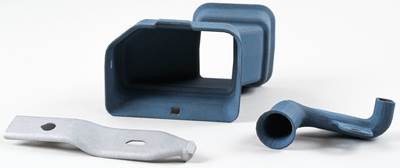What Holds AM Back in Automotive Production? GM Additive Lead Describes Advances Needed
“If AM were cheaper, we would be doing more of it,” says GM’s Paul Wolcott. Various important factors relate to cost. However, the driving factor affecting cost is speed.
Can additive manufacturing deliver end-use part production for the automotive industry? It is already doing so in certain cases. For automaker GM, 3D printing has provided bridge production of an SUV component during the wait for mold tooling, and it is established for making end-use parts on Cadillac high-end models, including 115 end-use 3D printed parts on the Cadillac Celestiq. These are all low-quantity applications relative to what is typical of the auto industry. What advances will enable AM to go farther in automotive production? Stated another way, what holds AM back from being more of a production solution for automakers?

The 3D printed bracket in the foreground is for ultraluxury low-quantity Cadillac models. It secures a wiring harness. The aluminum part would otherwise be a stamping, so AM allows it to be made without tooling. The part behind it, a duct, is also 3D printed. Read more about Cadillac AM parts. Photo: GM.
Paul Wolcott, lead engineer for additive manufacturing with GM, addressed this within a talk he gave at a recent ASTM International Additive Manufacturing Center of Excellence Workshop held at the Ohio State University. As part of that talk, he squarely listed the areas of advance he sees as important for enabling AM to better serve the auto industry as a production solution. To be clear, AM already plays a significant, growing role for automotive as a solution both for tooling and for other production hardware. But when it comes to directly making parts, Wolcott says the factors holding AM back from fuller and more dedicated production applications chiefly include these:
1. Cost
“If AM were cheaper, we would be doing more of it,” he says. Opportunities including assembly consolidation and freedom from the need for tooling are too great for automakers not to want to 3D print — but the part cost is frequently too high. And in the case of additive parts, Wolcott observes that cost is largely another way of seeing insufficient speed. “Currently the largest fraction of cost is machine throughput,” he says.
2. Material
Automotive production justifies materials tailored to this use. AM alloys that are specific to automotive applications will allow for properties and performance tuned to auto needs, reducing cost.
3. Takt time
This is a term not often associated with additive equipment, but it should be. Takt time is a vital measure of availability for any equipment that will deliver automotive production. Currently, machine turnover time in additive is too long, while uptime is too low. Improvement in these numbers is needed.
4. Finishing
3D printing implies the hope of being able to create a finished part in one operation. In reality, downstream work is generally required for AM components. If parts could come off the 3D printing machine suitable for the vehicle, Wolcott suggests this would go a long way toward making additive more attractive for production.
5. Supply base
Contract AM part producers often do not understand the auto industry Production Part Approval Process (PPAP). To address this, the choices available to an automaker like GM come down to “working with AM companies on automotive practices, or working with automotive suppliers on additive,” Wolcott says, adding, “We have done both.”
Related Content
How Norsk Titanium Is Scaling Up AM Production — and Employment — in New York State
New opportunities for part production via the company’s forging-like additive process are coming from the aerospace industry as well as a different sector, the semiconductor industry.
Read MoreThis Drone Bird with 3D Printed Parts Mimics a Peregrine Falcon: The Cool Parts Show #66
The Drone Bird Company has developed aircraft that mimic birds of prey to scare off problem birds. The drones feature 3D printed fuselages made by Parts on Demand from ALM materials.
Read MoreActivArmor Casts and Splints Are Shifting to Point-of-Care 3D Printing
ActivArmor offers individualized, 3D printed casts and splints for various diagnoses. The company is in the process of shifting to point-of-care printing and aims to promote positive healing outcomes and improved hygienics with customized support devices.
Read MoreAt General Atomics, Do Unmanned Aerial Systems Reveal the Future of Aircraft Manufacturing?
The maker of the Predator and SkyGuardian remote aircraft can implement additive manufacturing more rapidly and widely than the makers of other types of planes. The role of 3D printing in current and future UAS components hints at how far AM can go to save cost and time in aircraft production and design.
Read MoreRead Next
Cadillac Blackwing Models Are First GM Cars Using Additive Manufacturing for Full-Scale Production
Three functional components are 3D printed thanks to cost savings and design freedom. Layers lines on the shift knob signify this advance.
Read MoreWhat Does Additive Manufacturing Readiness Look Like?
The promise of distributed manufacturing is alluring, but to get there AM first needs to master scale production. GKN Additive’s Michigan facility illustrates what the journey might look like.
Read MoreIn Automotive, Is Additive Manufacturing an Answer for Die Cast Tooling?
The largest high-pressure die cast tool builder in North America is 3D printing die inserts and water jackets for major automakers. It’s a tough sell, but one company is succeeding — and it’s just getting started.
Read More





















